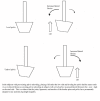Anatomic and functional leg-length inequality: a review and recommendation for clinical decision-making. Part II. The functional or unloaded leg-length asymmetry
- PMID: 16080787
- PMCID: PMC1198238
- DOI: 10.1186/1746-1340-13-12
Anatomic and functional leg-length inequality: a review and recommendation for clinical decision-making. Part II. The functional or unloaded leg-length asymmetry
Abstract
Background: Part II of this review examines the functional "short leg" or unloaded leg length alignment asymmetry, including the relationship between an anatomic and functional leg-length inequality. Based on the reviewed evidence, an outline for clinical decision making regarding functional and anatomic leg-length inequality will be provided.
Methods: Online databases: Medline, CINAHL and Mantis. Plus library searches for the time frame of 1970-2005 were done using the term "leg-length inequality".
Results and discussion: The evidence suggests that an unloaded leg-length asymmetry is a different phenomenon than an anatomic leg-length inequality, and may be due to suprapelvic muscle hypertonicity. Anatomic leg-length inequality and unloaded functional or leg-length alignment asymmetry may interact in a loaded (standing) posture, but not in an unloaded (prone/supine) posture.
Conclusion: The unloaded, functional leg-length alignment asymmetry is a likely phenomenon, although more research regarding reliability of the measurement procedure and validity relative to spinal dysfunction is needed. Functional leg-length alignment asymmetry should be eliminated before any necessary treatment of anatomic LLI.
Figures
References
-
- Travell JG, Simons DG. Myofascial Pain and Dysfunction The Trigger Point Manual The Lower Extremities. 2. Vol. 2. Williams & Wilkens: Baltimore; 1999. Chapter 4, Quadratus Lumborum Muscle; p. 42,35,35,42,107.
-
- Mannello DM. Leg Length Inequality. J Manipulative Physiol Ther. 1992;15:576–590. - PubMed
-
- Walker BF, Buchbinder R. Most commonly used methods of detecting subluxation and the preferred term for its description: a survey of chiropractors in Victoria, Australia. J Manipulative Physiol Ther. 1997;20:583–588. - PubMed
-
- White A, Panjabi M. Clinical Biomechanics of the Spine. Philadelphia: J.B. Lippincott; 1987. p. 96,352.
-
- Gossman MR, Sahrmann SA, Rose SJ. Review of length-associated changes in muscle. Physical Therapy. 1982;62:1799–1807. - PubMed
LinkOut - more resources
Full Text Sources


